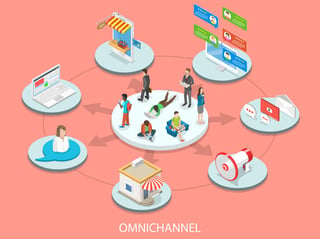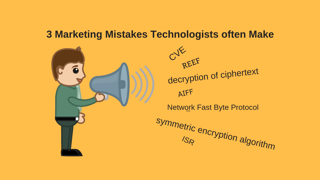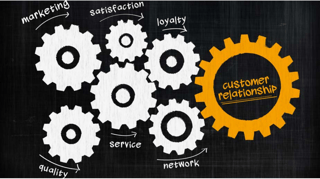Growth Insights for CEOs
The Chief Outsider
Recent Posts

AI Search is Here – And it’s Reshaping the Buyer Journey
Part 1 of our four-part series exploring how AI search is transforming visibility, SEO, and digital strategy - and what CEOs need to do now to stay competitive.
| Executive Takeaways |
| Declining web traffic isn’t random - it’s a symptom of changing search behavior. AI search is already impacting over 25% of user journeys - and growing fast If you’re not being cited, you’re missing opportunities-period. |
Recent Posts

Ready, Set, Innovate: Four Questions to Ask Before you Launch New Products
Fri, Nov 30, 2018 — Taste can be a fickle thing. When a finicky public is constantly demanding the newest, best, and latest of your enterprise, it puts an insane amount of pressure on you to meet their changing demands. Companies often respond to this challenge by launching new products or services. This solution should be carefully considered, and prepared for.

A CEO’s Guide to Modern Marketing Transformation
Thu, Nov 29, 2018 — Lather. Rinse. Repeat. There’s a reason that some things – like the number of tires on a car -- or in this example, how we use shampoo – remain decidedly the same. The old axiom that tells us not to fix what “ain’t broke” has served humankind well for generations. For successful businesses, it has been hard to argue with the status quo. For those fortunate to celebrate multiple years of exponential growth while deploying tried-and-true business strategies, it makes sense to keep doing what’s working.

Maximize Your Growth Potential by Supercharging Your Learning Agility
Thu, Nov 15, 2018 — Imagine how much more money your company could make if you never made the same mistake twice. How much more successful would you be if you could quickly course correct every time a plan went awry? What new growth initiatives could you pursue with expanded capabilities? How much would your productivity increase if you could improve your ability to attract and retain top talent? Supercharging your company’s learning agility can drive material improvement in each of these areas. It will also enable your company to maximize its growth potential. Learning agility is the willingness and ability to learn from experience and insight, then leverage that learning to perform better. While companies have always needed to learn and adapt to be successful, changes in technology, consumer preferences, and political and economic forces make it difficult for them to keep their growth plans on course. Access to data and emerging technology has weakened industry barriers to entry, while simultaneously leveling the playing field for competitors. In today’s complex business environment, companies that learn and adapt will be the most successful.
Stay up-to-date with the latest from Chief Outsiders

Sales vs. Marketing: Chicken or Egg First?
Thu, Nov 15, 2018 — What comes first, adding a sales person or having ready prospects and opportunities to pursue? I once worked for a company where Sales held all the power – more than product development or finance and certainly more than marketing. I recall a discussion with a long-time senior executive about the amount of marketing investment required for the company to profitably grow. She commented that the company had a tried and true method of driving growth. “We don’t need to invest in marketing. For every sales person we add, then revenue will grow!”, she proudly exclaimed. This had indeed been true at one time in the company’s history, but along with that revenue growth came increased expenses and decreasing sales productivity. The company eventually went through an inevitable and painful exercise of downsizing a much too large sales force.

Omnichannel or Tunnel Vision?
Tue, Nov 6, 2018 — Journey with me back a few years, to a time when books were bought at a bookstore, clothing purchased at an apparel shop, and the concept of competitive shopping was limited to letting our fingers do the walking. Today, consumers are fully – and indelibly – in control. Selling our stuff to this finicky lot requires a trip to their dimension – or we risk them not hearing us. That’s why today’s CEO is being assaulted by entreaties to institute an omnichannel strategy as an essential piece of their competitive marketing plan.

3 Marketing Mistakes Technologists Often Make
Fri, Oct 12, 2018 — Over the years, I’ve enjoyed working with some brilliant minds from the technology world. From my early days in Telecom and the pioneering days of interactive TV, to the groundbreaking revolution in eCommerce, smart technologists have astounded me with their vision and capabilities. As marketers, however, I find that they often fall short in a few areas. First, technologists tend to err on the side of verbosity, telling people everything their product can do. This lack of focus often results in confusion, and worse yet, a failure to connect to the prospects’ needs. Sometimes this problem occurs in the development stage as a result of what I like to call, “because we can” technical development. In this case, the developers decide to throw in every feature they can think of—whether or not their customers care. But often, wordiness is simply the result of excitement about all the things the company can do.

Shift Your Brand Perception – Tips for Getting Your Positioning to ‘Stick’
Thu, Oct 4, 2018 — After reading my previous posts, you’re almost on your way to productively and energetically leveraging your brand’s perception to drive company growth and profitability. Our previous topics of focus covered the specific impact that brand perception can have on the bottom line, the need for clear positioning as the foundation for communicating about your company, and some keys to arming others with that positioning so they can get your story into the market. Now, I’ll review the most important tips on what it takes to get your positioning to stick – to successfully change brand perception to accelerate growth and profitability.

Shift Your Brand Perception – Rally Others to Tell Your Story
Thu, Sep 27, 2018 — After reading my previous posts, you’re almost on your way to productively and energetically leveraging your brand’s perception to drive company growth and profitability. Our previous topics of focus covered the specific impact that brand perception can have on the bottom line and the need for clear positioning as the foundation for communicating about your company. It’s now time to examine effective ways to arm others with that refined market positioning. By understanding your story, employees, customers and other influencers will help you communicate this information to your marketplace. This strategy takes some of the pressure off your sales team. It also makes it easier to proliferate your vision, as well as the value of your product and service offerings. One of the biggest challenges small to mid-size companies face is promoting their company with limited resources. Not everyone has massive advertising budgets to flood the market, so you need to work smarter to get the most out of your marketing spend. One way to do that is to more effectively leverage your employee base and others who have influence in your industry. It’s much more powerful when others can tell the story for you.

Shift Your Brand Perception - Start with Getting Your Positioning Right
Thu, Sep 20, 2018 — In my previous post, we reviewed how brand perception specifically impacts company growth and profitability. Now we’ll cover the keys to building the foundation for communicating about your company. When companies start out, they usually have a very clear understanding of who their customer is, the problem they are solving, and possibly, how they are different. This is typically because they have a single product for a single market segment where they’ve achieved some level of success. But over time, as companies and markets evolve: The competition becomes more intense, either through matching capabilities, building new capabilities or new competitors appearing. Customer needs and priorities change. What was important to a customer 3 years ago may not be as important today. The company enters new market segments or geographies. There may be subtleties between industries, regions and countries in terms of priorities and pain points. The company broadens its portfolio of offerings. As more products are developed and more problems addressed, there might be new buyers and other selling dynamics.
.png?width=1500&height=398&name=CO_Corporate%20Logo%202021_4C_HOR_FNL-1%20(1).png)